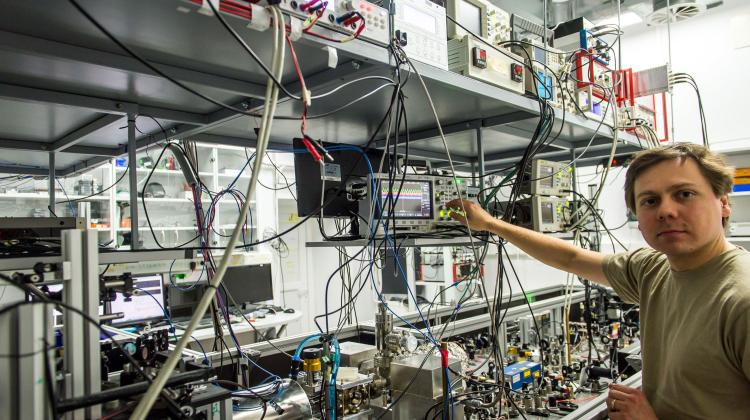Toruń physicists will improve the operation of the optical atomic clock
 Dr. Marcin Bober. Photo: PAP/ Tytus Żmijewski 23.01.2017
Dr. Marcin Bober. Photo: PAP/ Tytus Żmijewski 23.01.2017
Toruń physicists will improve the operation of the optical atomic clock. PLN 1 million grant will allow them to buy the world\'s most advanced equipment used to develop research, as well as the telecommunications and environmental industries.
"The developed and purchased equipment will be used to develop the optical atomic clock that we already have in Toruń. This will enable us to significantly expand its range of applications - in both fundamental research, as well as practical purposes. The former includes the search for dark matter, new physics using optical atomic clocks, which are now the most sensitive measuring devices in the world" - said Dr. Marcin Bober from the Institute of Physics of the Nicolaus Copernicus University in Toruń.
The researcher emphasized that such modern and innovative optical equipment is available only in a few top research centres in the world. At present, Spanish, Russian and Croatian researchers are following in the footsteps of the Toruń universities and building their atomic clocks. The time needed to build such equipment is at least several years.
"The new equipment will also be used for applied research that is relevant to environmental protection. This includes molecular spectroscopy, which allows us to investigate molecular transfers in gases that occur in our atmosphere, which in the future will be used, for example, to study greenhouse gas concentrations or concentrations other harmful pollutants" - Bober explained.
In addition, new technical solutions will enable the transmission of a very precise time and frequency signal. This will be achieved using the existing fibre optic network, and benefit both state research institutions and commercial companies, such as telecoms.
"This will allow to lend the signal from our optical atomic clock to other institutes not only in Poland but also in Europe. We will buy some parts from American and German companies, and we will build the rest from purchased - quite basic - components. This is always the cheapest and most effective solution. We can build it ourselves in our institute. Many people could not believe that we were able to build an optical atomic clock in such a short time. We did that really fast indeed" - the scientist added.
The physicist from the Nicolaus Copernicus University told PAP that scientists at his university were already working on further, world-class solutions.
"We already have an idea for a new generation of optical atomic clocks, which should be even better than what we have at the moment. These devices can be used for purely scientific research, such as the study of dark matter, but also in the search for natural resources" - Bober pointed out.
According to the expert, it takes about 5 to 8 years to bring such equipment "to the public". "According to realistic and possible estimates, a new generation of OAC for laboratory use can be created in about three years" - he concluded.
PAP - Science and Scholarship in Poland
twi/ zan/ kap/
tr. RL
Przed dodaniem komentarza prosimy o zapoznanie z Regulaminem forum serwisu Nauka w Polsce.














